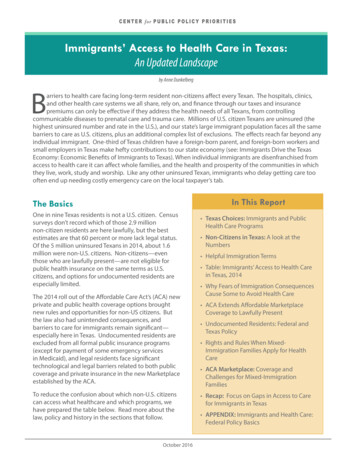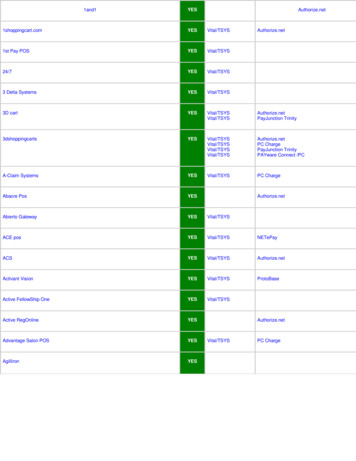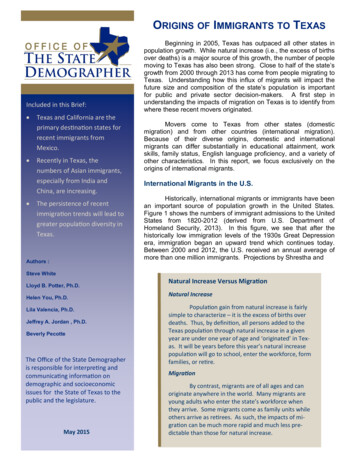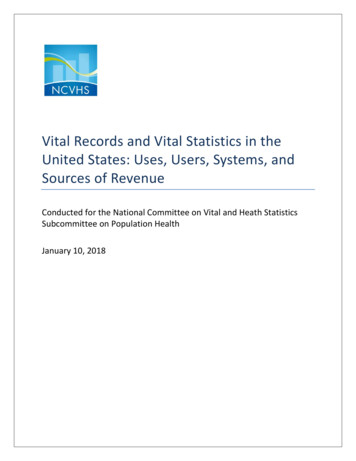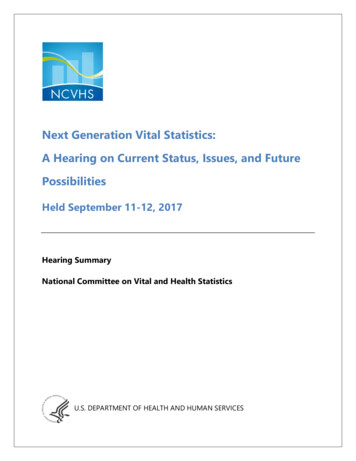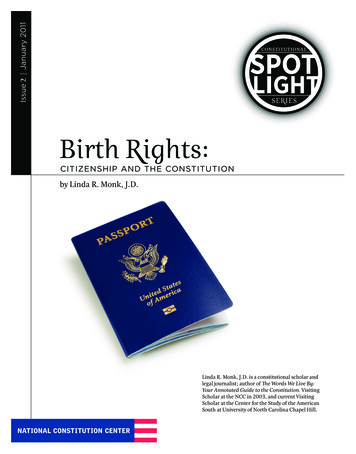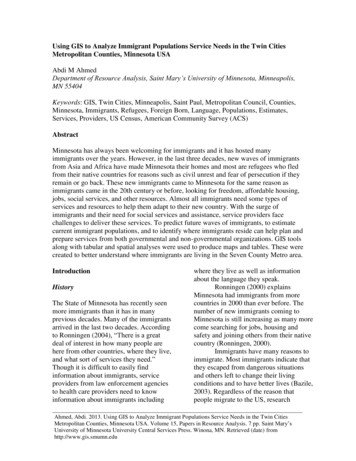
Transcription
Immigrants Are Vital to the U.S. EconomyThe COVID-19 crisis has brought renewed attention to the role of immigrants in the U.S.economy. Immigrants disproportionately work in the jobs labeled “essential” during the springlockdowns in 2020, placing many of them on the front lines of the crisis. While initiallyimmigrants were more negatively impacted by the coronavirus recession, immigrants are onceagain poised to play a vital role in the economic recovery and future economic growth. Theirspending power, relative youth, high levels of involvement in STEM fields, and high rates ofentrepreneurship make them key contributors to our economy.Immigrants in the United States make up approximately 1-in-7 residents, 1-in-6 workers andcreate about 1-in-4 of new businesses.1 Immigrants are diverse in many ways: country of origin,race and ethnicity, education and occupation.2 Nearly half of all immigrants are naturalizedcitizens (20.7 million), 27 percent are lawful permanent residents (12.3 million) and 5 percentare temporary residents with legal status (2.2 million).3 Less than one-fourth of the foreign-bornpopulation (10.5 million) are undocumented.4 Immigrants are more likely to be of prime workingage (between 25 and 54 years old), balancing out the relatively older native-born population.5IMMIGRANTS ARE MORE LIKELY TO BE “ESSENTIAL” WORKERSWhen the coronavirus pandemic reached the United States in early 2020 and much of theeconomy was forced to shut down, the Department of Homeland Security took steps to labelsome workers “essential,” excluding them from local and state stay-at-home orders.
Immigrants Are Vital to the U.S. EconomyImmigrants disproportionately work in the jobs that were labeled essential. As of 2020, therewere 19.8 million foreign-born “essential” workers, working in jobs arrayed across sectors andskill-levels. A higher share (69 percent) of all immigrants, and undocumented immigrants (74percent), are in the essential work categories compared to native-born workers (65 percent).6 Asa result, they may have been more likely to contract and die from COVID than native-bornAmericans.7Immigrants Disproportionately Work in "Essential" SectorsShare of Workers Who AreImmigrantsSectorManufacturingTransportation and UtilitiesProfessional and Business ServicesLeisure and HospitalityAgriculture, Forestry, Fishing and rce: U.S. Census Bureau. “Foreign Born: 2019 Current Population Survey Detailed Tables - Table 1.8.Industry of Employed Civilian Workers 16 Years and Over by Sex, Nativity, and U.S. Citizenship Status: 2019."Accessed April 12, 2021. gn-born/cps-2019.html.Immigrant labor sustains the U.S. food supplyForeign-born workers account for more than 1-in-5 of all workers spread across the U.S. foodsupply chain — growing crops, harvesting fruits and vegetables, processing meat, transportingproducts and materials, and engaging in wholesale and retail sales.8 Immigrants comprise morethan 30 percent of many of the most physical of these jobs: farm laborers, graders and sorters,crop production, meat processing and commercial bakeries.9 In some states, the majority ofworkers in these jobs are immigrants. Foreign-born workers make up: 69 percent of the agricultural workers in California,70 percent of the seafood processing workers in Alaska and66 percent of the meat processing workers in Nebraska.10Despite the acute health risks of the pandemic and chronic low pay, foreign-born workers whofeed the U.S. continued to show up to work due to economic necessity.11 Meanwhile, amid fearsof food shortages and rotting produce, few policies were enacted to improve the conditions forthose contributing to the food supply chain. Migrant workers—even those with H-2A visas,which enable noncitizens to work in the agricultural sector—have little leverage to seekimproved working or living conditions for fear of deportation or losing their visas if they leavetheir job.12 Because of these and other factors, unsafe work and living conditions that exacerbatePage 2
Immigrants Are Vital to the U.S. EconomyCOVID-19 risks for migrant workers, their families and their communities have goneunaddressed during the pandemic.13Immigrant health care workers are disproportionately responsible for in-person careIn addition to their over-representation in jobs in the food supply chain, immigrants also play anoutsized role in the U.S. response to the COVID-19 pandemic in the health care services sector.While some health care occupations moved their contact with patients to primarily online modes,immigrants are overrepresented in many health care jobs that require close contact with the sickand highest-risk individuals during the pandemic. Public-facing health care jobs—includingnurses and medical assistants—sometimes require non-English language skills. For example,most medical interpreters are immigrant workers.14Immigrants make up 38 percent of home health aides, 29 percent of physicians and 22 percent ofnursing assistants.15 As Baby Boomers age and the health care system faces increasing demand,immigrants will play an even more critical role in some of the fastest-growing health careoccupations, such as licensed registered nurses and certified home health aides.16IMMIGRANTS ARE DRIVING OUR ECONOMIC RECOVERYDespite being hit hard by the recent economic contraction, immigrants were quick to lead therecovery effort by returning to the labor force. With their return to the labor force and theirspending power, immigrants are helping drive the economic recovery for all Americans.Already, the gap between the employment-population ratios of the foreign- and native-bornpopulations is widening, with foreign-born workers returning to the labor force at a faster rate.While this may be partly driven by limited access to unemployment insurance and other forms ofrelief, their relatively rapid return to work fits with data from previous recessions and representsa positive development for the nation’s ongoing recovery.Immigrants were initially hit harder by the COVID-19 recessionFrom February to April 2020, the unadjusted unemployment rate for native-born workersincreased from 3.8 percent to 14 percent. Foreign-born workers experienced an unprecedentedincrease, with one-in-five losing their jobs and the unemployment rate climbing from 3.6 percentto 16.5 percent.Page 3
Immigrants Are Vital to the U.S. EconomyThe unequal impact of the COVID-19 contraction could be partly explained by the fact thatforeign-born workers disproportionately work in the occupations that experienced the highest jobloss during the initial labor market collapse in April 2020.17Immigrants’ employment rate typically rebound more quickly from downturnsHistorically, immigrants’ employment rates rebound more quickly from recessions, making themintegral to a speedy recovery as their earnings fuel spending and further growth.18 In the GreatRecession, foreign-born workers were hard hit — losing over a million jobs. However, within ayear, foreign-born worker employment returned to pre-recession levels relative to native-bornworkers.According to an analysis by the Pew Research Center, immigrants accounted for all of the jobgains in the first year of recovery after the Great Recession (from the second quarter of 2009 toPage 4
Immigrants Are Vital to the U.S. Economythe second quarter of 2010). Immigrants gained 656,000 jobs and 566,000 entered the laborforce. Native-born workers, by comparison, lost 1.2 million jobs and 633,000 exited the laborforce.Similarly, in the recovery from the coronavirus recession, the employment rates for foreign-bornworkers have bounced back quickly.The spending power of immigrants will help fuel the recoveryImmigrants are not only workers, they are also consumers. According to an analysis of 2019American Community Survey (ACS) data by the New American Economy, immigrants (14percent of the U.S. population) wield 1.3 trillion in spending power.19 In some of the largeststate economies the contributions of immigrants are substantial. In California, the immigrant share of the population is 27 percent and immigrantspending power is 318 billion. In New York, the immigrant share of the population is 22 percent and immigrantspending power is 130 billion. In Texas, the immigrant share of the population is 17 percent and immigrant spendingpower is 120 billion. In Florida, the immigrant share of the population is 21 percent and immigrant spendingpower is 105 billion.Immigrants are poised to play a large role in the economic recovery as they return to work andregain some of this spending power. Their ability to spend more will further drive demand forgoods and services that will help bring workers back into the ranks of the employed.IMMIGRANTS ARE POSITIONED TO MAKE OUTSIZED CONTRIBUTIONS TOLONG-TERM ECONOMIC GROWTHImmigrants are younger, more likely to work in STEMImmigrants are more likely to be of prime working age (between 25 and 54 years old), balancingout the relatively older native-born population.20 They also are less likely to be children: only 6percent are under 18 years old, compared to 25 percent of the native-born. The consequence ofthis age breakdown is that foreign-born residents are disproportionately workers, activelycontributing to programs like Social Security. In 2019, immigrants paid 492 billion in state,local and federal taxes.21Much of the projected job growth in the United States is in STEM fields (Science, Technology,Engineering and Math).22 Because U.S. universities are under producing graduates with STEMdegrees and the skills to fill STEM positions, companies need immigrants to help fill these skillgaps. In recent years, immigrants with STEM degrees have made up an increasing share of theinnovators responsible for new U.S. patents. Foreign-born innovators are responsible for morethan 75 percent of patents from the top ten patent-producing U.S. universities.23Page 5
Immigrants Are Vital to the U.S. EconomyImmigrants are more likely to start businessesImmigrants are more likely than the native-born to start businesses or pursue other forms of selfemployment. This entrepreneurship makes immigrants essential for encouraging future economicdynamism, innovation and long-term economic growth.Immigrant entrepreneurs are overrepresented among non-white business owners. Three-fourthsof all businesses owned by Asians are owned by immigrants. Immigrants also own about half ofall Hispanic-owned firms and about one-fourth of all Black-owned companies.24 Data from theSurvey of Business Owners shows first-generation immigrants open about 25 percent of newfirms in America.25Immigrant entrepreneurs take on significant risks to start their businesses. In 2016, they owned22 percent of businesses in higher-risk industries, compared to 16 percent of all businesses.26These elevated risks were reflected in the number of immigrant-owned businesses that closedpermanently during the initial weeks of the pandemic. Foreign-born business ownership fell by36 percent during the onset of the COVID-19 outbreak, compared to an 18 percent decline innative-born business ownership.27The recovery of immigrant businesses is essential since these businesses create employmentopportunities for millions of workers. Over 3 million immigrant entrepreneurs employ almost 8million American workers across the nation.28 A study by the New American Economy estimatesthat immigrants and the children of immigrants have started almost half of all Fortune 500companies.29CONCLUSIONThe COVID-19 crisis has revealed that immigrant workers play a critical function in supplying“essential” labor in the service and agricultural sectors, as well as other parts of the economy.They are working on the front lines of the fight against the coronavirus pandemic in health careand other industries. Moreover, they are more likely to be entrepreneurs, hit hard by thecoronavirus recession but also uniquely positioned to drive the economic recovery.Since the founding of the nation, immigrants have played a vital role in creating a diverse,dynamic and growing U.S. economy. Immigrants help fuel economic activity through theirattachment to the labor market, their spending power and their entrepreneurial spirit behind muchof our innovations. To foster a stronger and more equitable American economy, new policiesmust build upon the essential contributions—and address the challenges of—the foreign-bornworkforce and immigrant-owned businesses.Page 6
Immigrants Are Vital to the U.S. EconomyKEY FACTS One-in-seven of the total U.S. population is foreign-born (46 million people). More than one-in-six workers in the United States are foreign-born (28 million workers). Almost half (48 percent) of the foreign-born labor force is Latino; one-quarter (25percent) is Asian; 10 percent is Black and 16 percent is White. Foreign-born workers are overrepresented in key occupations in the field of health,accounting for 38 percent of home health aides, 29 percent of physicians and 23 percentof pharmacists. Immigrants make up 22 percent of all workers in the U.S. food supply chain, even thoughthey comprise only 18 percent of the labor force. Primarily as a result of the coronavirus recession, the number of employed foreign-bornworkers dropped from about 28 million in February to 22 million in April 2020. The levelrecovered to approximately 26 million one year later in February 2021. About three-fourths of undocumented immigrants in the labor force are classified asessential. Immigrants start approximately 25 percent of new firms in the United States. The number of immigrant-owned businesses fell by 36 percent during the onset of theCOVID-19 outbreak, compared to an 18 percent decline in native-born businessownership.Page 7
Immigrants Are Vital to the U.S. EconomyDemographic, Economic and Vulnerability Indicators for the Foreign-BornPopulation by StateStateForeign-BornPopulation (#)% of Total % of LaborPopulationForce% of AllEssentialWorkers% Below the % NoncitizensPovertywith liforniaColoradoConnecticutDelawareDistrict of kaNevadaNew HampshireNew JerseyNew MexicoNew YorkNorth CarolinaNorth DakotaOhioOklahomaOregonPennsylvaniaRhode IslandSouth CarolinaSouth est .2%78.9%83.6%87.5%80.1%68.2%United States44,011,87013.6%17.5%18.3%15.4%79.8%Sources: 2015-19 American Community Survey: 5-Year Data; Center for Migration StudiesPage 8
Immigrants Are Vital to the U.S. EconomyU.S. Census Bureau. 2019. “Foreign Born: 2019 Current Population Survey Detailed Tables.” Table 3.1. Foreign-BornPopulation by Sex, Age, and World Region of Birth: 2019. -region-of-birth-tab1.xlsx; Wisenberg Brin, Dinah. 2018. “Immigrants Form 25% ofNew Businesses, Driving Entrepreneurship In ‘Gateway’ States.” -u-s-businessresearchers/?sh 2cbfe1ed713b; U.S. Bureau of Labor Statistics. 2020, May 29. “Foreign-born workers made up 17.4 percent oflabor force in 2019.” 019.htm?view full.12A little over half of all immigrants were born in Latin America. Approximately one-third were born in Asia, one-tenth inEurope and less than one-tenth in Africa or other regions.Pew Research Center. 2019. “Measuring Illegal Immigration: How Pew Research Center Counts Unauthorized Immigrants inthe U.S.” nts-in-us/.34Most undocumented immigrants entered the country with a temporary legal status that later expired. Others immigrated to theUnited States without authorization at the time of entry.Congressional Budget Office. 2020. “The Foreign-Born Population and Its Effects on the U.S. Economy and the Federal Budget— An Overview.” -immigration.pdf.U.S. Census Bureau. 2019. “Foreign Born: 2019 Current Population Survey Detailed Tables.” Table 3.1. Foreign-BornPopulation by Sex, Age, and World Region of Birth: 2019. -region-of-birth-tab1.xlsx; Pew Research Center. 2015. “Chapter 5: U.S. ForeignBorn Population Trends.” n, Donald, Mike Nicholson, Daniela Alulema, and Robert Warren. 2020. “US Foreign-Born Essential Workers by Statusand State, and the Global Pandemic.” Center for Migration Studies (CMS). s/.6Renwick, Danielle and Shoshana Bunow. 2020, August 26. “Many People of Color, Immigrants Among Over 1,000 US HealthWorkers Lost to COVID.” gration Policy Institute. 2020. “The Essential Role of Immigrants in the U.S. Food Supply d; United States Department of Agriculture (USDA). 2020. “Farm Labor.” April 22, farm-labor/#demographic.9Migration Policy Institute. 2020. “The Essential Role of Immigrants in the U.S. Food Supply ssenhop, Jessica. 2020. “The Untold Story behind America’s Biggest Outbreak.” BBC News, April 17, sec. US & 311877.11Willingham, Zoe, and Silva Mathema. 2020. “Protecting Farmworkers From Coronavirus and Securing the Food Supply.”Center for American Progress. navirus-securing-food-supply; Kirwan, Hope. 2020. “Wisconsin Farms Face New Worker Safety ChallengesDuring COVID-19 Pandemic.” Wisconsin Public Radio, June 22. r-safetychallenges-during-covid-19-pandemic; Crampton, Liz. 2020. “In Absence of Federal Action, Farm Workers’ Coronavirus CasesSpike.” Politico, June 10. ers-coronavirus-309897.12Newman, Etan. 2011. “No Way to Treat a Guest: Why The H-2A Agricultural Visa Program Fails U.S. and Foreign Workers.”Farmworker Justice. les/documents/7.2.a.6%20fwj.pdf.13New American Economy. 2020. “How Has the Labor Market Been Affected by g/report/labor-market-covid-19/.14“Immigrant Workers: Vital to the U.S. COVID-19 Response, Disproportionately Vulnerable” by Migration Policy Institute.Occupations that have a disproportionately higher share of foreign-born workers compared to their overall share in the labor force( 17.5%) shown15New American Economy. n.d. “Healthcare: How Immigration Plays a Critical Role.” Accessed June 12, lthcare/.16Bureau of Labor Statistics. 2020. “Employment Situation - April empsit 05082020.htm. Data are not seasonally adjusted.17Page 9
Immigrants Are Vital to the U.S. EconomyPew Research Center. 2010. “After the Great Recession: Foreign Born Gain Jobs; Native Born Lose n-jobs-native-born-lose-jobs/.18New American Economy. 2020. “Map the Impact of Immigration: U.S. Economic Data & Numbers.” 2020. New AmericanEconomy. January 31. https://www.newamericaneconomy.org/locations/. Estimates for share of the foreign-born populationslightly differ between 2018 ACS and 2014-2018 ACS data sources. 2014-2018 ACS data used to produce the county-level mapand state-level estimates in the table of this report.19U.S. Census Bureau. 2019. “Foreign Born: 2019 Current Population Survey Detailed Tables.” Table 3.1. Foreign-BornPopulation by Sex, Age, and World Region of Birth: 2019. -region-of-birth-tab1.xlsx; Batalova, Jeanne, Mary Hanna and Christopher Levesque.2021, February 11. “Frequently Requested Statistics on Immigrants and Immigration in the United States.” Migration PolicyInstitute. nited-states-2020.20New American Economy. 2020. “Map the Impact of Immigration: U.S. Economic Data & Numbers.” 2020. New AmericanEconomy. January 31. lberman, Alan and Lindsey Ice. 2021. “Beyond the Numbers: Why computer occupation are behind strong STEMemployment growth in the 2019-29 decade.” Bureau of Labor Statistics. th.htm#: :text or%20all%20occupations; New AmericanEconomy. 2021. “Innovation & STEM Fields.” on-stem-fields/; NewAmerican Economy. 2015. “Facts You Ca Use: To Prove That High-Skilled Immigration is Good for America’s Workforce andEconomy.” -CanUse-4-24-2015.pdf.22New American Economy. 2012, June 26. “Immigrants Are Behind More Than Three-Quarters of Patents from Top Ten PatentProducing American Universities.” ersities/.23Kochhar, Rakesh. 2020, April 23. “The financial risk to U.S. business owners posed by COVID-19 outbreak varies bydemographic group.” Pew Research Center. id.; Kerr, Sari Pekkala, and William R Kerr. 2018. “Immigrant Entrepreneurship in America: Evidence from the Survey ofBusiness Owners 2007 & 2012.” National Bureau of Economic Research, Working Paper 24494.https://doi.org/10.3386/w24494.25Kochhar, Rakesh. 2020, April 23. “The financial risk to U.S. business owners posed by COVID-19 outbreak varies bydemographic group.” Pew Research Center. irlie, Robert W. 2020, June. “The Impact of Covid-19 on Small Business Owners: Evidence of Early-Stage Losses from theApril 2020 Current Population Survey.” National Bureau of Economic Research.https://www.nber.org/system/files/working papers/w27309/w27309.pdf.27New American Economy. 2019, March 12. “New Data Shows Immigrant-Owned Businesses Employed 8 Million Americans;Immigrants Wield 1.1 Trillion in Spending Power.” n-spending-power/.28Fearnow, Benjamin. 2019. “Nearly Half of All Fortune 500 Companies Were Founded by Immigrants or Their Children, StudyFinds.” Newsweek, July 22, sec. Business. -500-companies-us-gdp1450498; New American Economy. 2019. “New American Fortune 500 in tune500-2019/; Hathaway, Ian. 2017, December 4. “Almost half of Fortune 500companies were founded by American immigrants or their children.” Brookings Institution. d-by-american-immigrants-or-their-children/.29Page 10
again poised to play a vital role in the economic recovery and future economic growth. Their spending power, relative youth, high levels of involvement in STEM fields, and high rates of entrepreneurship make them key contributors to our economy. Immigrants in the United States make up approximately 1-in-7 residents, 1-in-6 workers and


